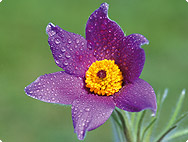
Pulsatilla pratensis (L.) MILK.
Wind Flower

History
The Greek physician Theophrastus (3rd century BC) named the plant ánemos (= wind) in reference to the shaggy little fruits that are dispersed by the wind. Pharmaceutically, it was formerly called ’Herba venti’. The species name pulsatilla derives from the Latin pulsare, meaning ’to ring or to sound’, in reference to the bell shape of the flowers. The old English common name was originally ‘pass flower’, adopted from the French ‘passe fleur’. Gerarde changed it to ‘pasque flower’ after the French ‘pasque’ (Easter). Hippocrates used the windflower to trigger menstruation and to treat states of hysterical fear. The ancient physicians attributed special potency to plants with hanging blossoms and, in accordance with the doctrine of signatures, prescribed them for patients who ”let their heads hang” (depression, melancholy). Matthiolus recommended windflower against quartan malaria and pestilence. In 1564, Lonicerus wrote: “The juice sprinkled in the nose purifies the brain. The root, when chewed, drives out phlegm. It purifies the foully stinking ulcer and heals rotten flesh.” Later, the windflower was extolled as a remedy for eye complaints such as cataracts and amaurosis and in the 18th century, several dissertations were written on this subject.
Botanical characteristics
The windflower is a perennial with a strong rootstock, from which densely-haired flower stalks grow to between 20cm and 40cm in height in the Spring. They bear three fused, hairy bracts that appear tattered in thin strips. The stalk generally bears a single flower with six bell-shaped, violet or reddish petals that turn in toward each other. They are silkily haired on the outside and rolled back at the tips. Numerous yellow stamens grace the interior of the bell. Long, small, hairy achenes (one seeded fruit) grow from the numerous ovaries with long, threadlike pistils; the achenes are carried away by the wind. The basal, triply to quadruply pinnate leaves with white, tufty hair appear after the plant has flowered. The windflower blossoms from April to June.
Habitat
The windflower is native to Central and Eastern Europe and as fareast as Siberia. It thrives on dry, sunny, infertile meadows and slopes in sparse pine forests with sandy or limy soils on plains and in elevations up to 1000metres. It disappears at once if the ground is fertilised. It cannot survive on fertilised ground. In Switzerland, all species of Pulsatilla are protected by law.
Preparation
A.Vogel/Bioforce uses a homeopathic dilution in accordance with the current Homöopathisches Arzneibuch (HAB) (New Official German Homoeopathic Pharmacopoeia) produced from the fresh, whole Pulsitilla pratensis plants gathered at blossoming. The potentising is carried out by shaking manually immediately after the primary tincture is produced, in order to prevent any deterioration of the effective agents.
A.Vogel Blog – Natural and Healthy
Inspiration for a healthy life!
HERBAMARE SOUP-ER SOUPS!
DOWNLOAD YOUR FREE RECIPE BOOKLET!
8 healthy, hearty and delicious homemade soups.
Supporting a healthier happier you
“Nature is just about the best thing we’ve got!“
Alfred Vogel's guide to leading a healthy and happy life
Healthy & nutritious dinner ideas
Get new recipes in your inbox every month. Sign up now